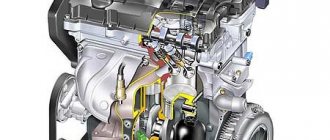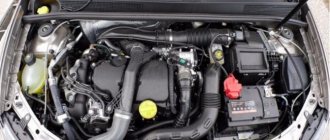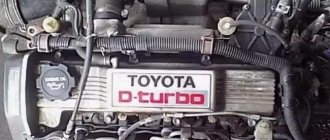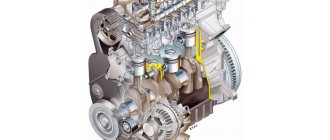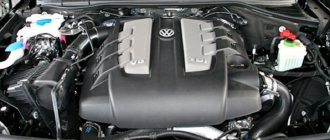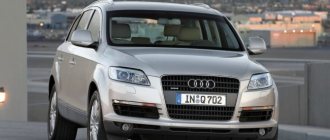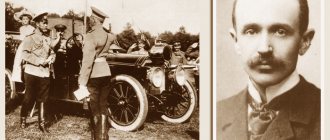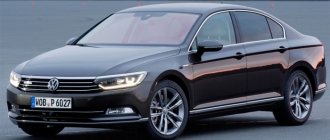Characteristics of 2.0 TDI EA189 engines
| Production | Volkswagen |
| Engine make | 2.0 TDI EA189 |
| Years of manufacture | 2007—2016 |
| Cylinder block material | cast iron |
| engine's type | diesel |
| Configuration | in-line |
| Number of cylinders | 4 |
| Valves per cylinder | 4 |
| Piston stroke, mm | 95.5 |
| Cylinder diameter, mm | 81 |
| Compression ratio | 16.5 |
| Engine capacity, cc | 1968 |
| Engine power, hp/rpm | 84/3500 102/3500 110/4200 114/3500 140/4200 143/4200 150/4200 163/4200 170/4200 177/4200 180/3500 |
| Torque, Nm/rpm | 220/1250—2500 250/1500—2500 250/1500—2500 250/1500—2750 320/1750—2500 320/1750—2500 320/1750—2500 400/1750—2500 350/1750—2500 380/1750—2500 400/1500—2000 |
| Environmental standards | Euro 4 Euro 5 |
| Turbocharger | BorgWarner BV40 BorgWarner BV43 Garrett GTC1446VZ Garrett GTC1459MVZ Garrett GTC1549MVZ |
| Engine weight, kg | 165 |
| Fuel consumption, l/100 km (for Golf 6) - city - highway - mixed. | 6.3 4.1 4.9 |
| Oil consumption, g/1000 km | up to 500 |
| Engine oil | 5W-30 |
| How much oil is in the engine, l | 4.3 |
| Oil change carried out, km | 15000 (better 7500) |
| Engine operating temperature, degrees. | — |
| Engine life, thousand km - according to the plant - in practice | — 350+ |
| Tuning, hp — potential — without loss of resource | 200+ — |
| The engine was installed | VW Caddy Volkswagen Golf VW Jetta Volkswagen Passat VW Passat CC VW Tiguan Audi A3 Audi A4 Audi A5 Audi A6 Audi Q5 Skoda Octavia Skoda Superb Skoda Yeti Audi A1 Audi TT Audi Q3 VW Eos VW Beetle VW Scirocco Volkswagen Sharan VW Touran SEAT Alhambra SEAT Altea SEAT Exeo SEAT Ibiza SEAT Leon |
What diesel engines are installed on the Touareg
Experts and car enthusiasts say that the best diesel engine in the Tuareg is 3 liters with 240 hp. But this is not the only type of motor that is installed on these models. What a diesel Volkswagen Touareg engine might be like is clear from the table below.
| Power, hp | Volume, l | Transmission | Year of issue | Brand | Price, rubles |
| 163 | 2,5 | Manual transmission, automatic transmission | 2002, 2006 | BLK, BPD | |
| 174 | 2,5 | Manual transmission, automatic transmission | 2002, 2006 | BAC, BPE | 400,000 (used) |
| 225 | 3,0 | Manual transmission, automatic transmission | 2002 | BKS, CATA | |
| 220 | 3,0 | Automatic transmission | 2002 | BKS, CATA | |
| 313 | 4,9 | Automatic transmission | 2002, 2006 | AYH, BLE, BWF | |
| 224 | 3,0 | Automatic transmission | 2006 | BKS, CATA | 670,000 (used) |
| 240 | 3,0 | Manual transmission, automatic transmission | 2006 | CASA, CASC | |
| 351 | 4,9 | Automatic transmission | 2006 | CBWA | 525,000 (used) |
| 204 | 3,0 | Automatic transmission | 2010, 2014 | CASD, CJMA | 2,390,000 (used) |
| 240 | 3,0 | Automatic transmission | 2010 | CNRB, CASA | |
| 245 | 3,0 | Automatic transmission | 2010, 2014 | CJGD, CRCA | 1,799,000 (used) |
| 340 | 4,1 | Automatic transmission | 2010, 2014 | CKDA | 1,900,000 (used) |
| 249 | 2,0 | Automatic transmission | 2018 | CYRC | 4,571,000 (new) |
| 249 | 3,0 | Automatic transmission | 2018 | CVMD | 5,449,500 (new) |
The most popular model among car owners is the Touareg 3.0 diesel. Models with such an engine have an optimal combination of power, performance, fuel consumption, and ease of maintenance. The Tuareg 2.5 diesel is slightly less popular, but it is also a favorite of Russian drivers who prefer luxury crossovers.
Photo Touareg V8 TDI
Specifications
Reviews about the Volkswagen Touareg diesel SUV are different, but most of the owners are happy with the car. This applies to both old models and new ones released in 2021. Each model has its own technical characteristics, but for evaluation it is worth considering the model produced from 2014 to 2018 - Volkswagen Touareg 3.0 TDI.
Read also Review of Volkswagen Amarok 2021
This is a five-seater SUV, all-wheel drive, with a 3.0 liter V6 turbodiesel engine producing 245 hp. Claimed power is achieved at 3800 rpm. The car can reach speeds of up to 220 km/h. The acceleration of the Tuareg to 100 is interesting; the Tuareg diesel has a good performance of 7.6 seconds.
The model has an 8-speed automatic transmission and independent multi-link suspensions front and rear. Brakes are ventilated discs on both the front and rear wheels. Dimensions of the car – 4801×1940×1709 mm, weight 2148 kg.
Photos of Volkswagen Touareg 3.0 TDI
Claimed fuel consumption
For this model, the manufacturer indicates three modes in which the Tuareg diesel fuel consumption will be different:
- urban - 8.8 l per 100 km;
- outside the city - 6.5 liters per 100 km;
- mixed mode - 7.4 l per 100 km.
Actual consumption will vary depending on driving conditions in each mode, owner's driving style and other factors. But, as reviews of the Tuareg (3 liter, diesel) show, it consumes much less fuel than the same model with a gasoline engine.
2011 Volkswagen Touareg 3.0 TDI Clean Diesel
Reliability, problems and repairs Volkswagen 2.0 TDI
The two-liter four-cylinder diesel engine of the EA188 series went into production in 2003 and was created using a 1.9 TDI 130 hp. of the same EA188 family. Here the cylinder diameter was increased from 79.5 to 81 mm, which made it possible to obtain an extra 100 cc. cm of working volume and reach a round figure of 2.0 liters.
This engine received a completely different head with two camshafts and 16 valves. The diameter of the intake valves is 29.4 mm, the exhaust valves are 25.5 mm, the stem thickness is 6 mm. The camshafts rotate from the timing belt, which must be changed every 120 thousand km. Like the 1.9 TDI, pump injectors are used here, which is why engines in this series are called 2.0 TDI PD (Pumpe-Düse). These engines are equipped with a Garrett GT1749VA turbine. These engines develop 140 hp. and have many symbols. We have mentioned them below.
In 2005, a more powerful modification was released, which is quite different: a reinforced crankshaft was installed, new pistons, balancer shafts were installed on longitudinal engines, the head was redesigned, where cooling was improved, valve seats were changed, valves with flat plates were installed, new piezo injectors, spark plugs, and the cylinder head was covered with a modified cover. These internal combustion engines have a particulate filter and their own EGR valve. The Garrett GT1749VC turbine is used here. All these modifications made it possible to obtain 170 hp.
In addition to 16-valve versions, 8-valve versions with a single camshaft were also produced. Such engines were equipped with balancer shafts and a Garrett GT1646V turbine. They develop a power of 140 hp.
Since 2007, all these engines have been replaced with 2.0 TDI common rail EA189 series.
Modifications of 2.0 TDI engines
1. AZV (2003 - 2010) - the first version with a DOHC head and a Garrett GT1749VA turbine. Engine power 136 hp. 2. BKD (2003 - 2011) - the same AZV with different firmware. Power increased to 140 hp. 3. BLB (2004 - 2005) - longitudinal version of BKD with balancer shafts. 4. BRE (2005 - 2008) - replacement of the BLB with a different oil cooler and other little things. 5. BKP (2005 - 2008) - analogue of BRE for Passat with piezo injectors. 6. BMN (2005 - 2009) - transverse version with 170 hp. 7. BMR (2006 - 2008) - 170 hp version. for Passat. 8. BRD (2006 - 2008) - an analogue of the BMN with a BV43 turbine. 9. BMM (2005 - 2010) - engine with an 8-valve SOHC head and a particulate filter. Power 140 hp 10. BMP (2005 - 2010) - analogue of BMM with balancer shafts. 11. BMA (2005 - 2009) - 8-valve version with Garrett GT1749VA turbine for Passat with 136 hp. 12. BRT (2005 - 2010) - analogue of BMA with BV39 turbine for VW Sharan and Seat Alhambra. Power 140 hp 13. BGW (2003 - 2005) - engine with SOHC head and GT1749VA turbine for VW Passat B5.5 with manual transmission. Engine power 136 hp. 14. BHW (2003 - 2005) - analogue of BGW for automatic transmission. 15. BDJ (2003 - 2010) - 8-valve naturally aspirated version for Volkswagen Caddy under Euro-3. 16. BST (2003 - 2010) - analogue of BDJ under Euro-4. Was on a Volkswagen Caddy. 17. BDK (2004 - 2008) - naturally aspirated version with SOHC head for Golf 5. Power 75 hp. 18. BSS (2005 - 2008) - turbodiesel with SOHC head, with a Garrett GT1749VA turbine and a particulate filter. The engine is found only on the Skoda Superb. 19. BPW (2004 - 2009) - 8-valve version for Audi A4 with GT1749VA turbine.
Problems and reliability of the 2.0 TDI
1. Worn hexagon of the oil pump drive. Approximately every 150-200 thousand km, the hexagon faces wear out, then the oil pressure drops and the engine becomes unusable. There is only one way out - replace the hexagon with a new one every 150-200 thousand km 2. Increasing the oil level. This may seem strange, but you need to look towards the particulate filter, most likely the problem is there. If this does not help, then check the injectors. 3. Loss of traction, overblowing. Most likely you have problems with stuck turbine geometry. Check, repair, or save time and buy a working turbine.
Motors with 170 horses had problems with injectors at the beginning of production and campaigns were carried out to replace them. Despite all this, 2.0 TDI PD engines are very reliable and, with adequate regular maintenance, have a very long service life, they run 400-500 thousand km or more.
Modern modifications of diesel engines Volkswagen Jetta V - VI
As practice shows, Volkswagen still said goodbye to the technology of the past, in the form of an injector, as well as other imperfect parts in its TDI engines, which were mainly installed on the Jetta V. They were considered the leading power plants running on diesel fuel. The next innovation was the diesel Volkswagen Jetta, with a 1.6 TDI CR 90 hp unit.
However, a little more time passed before the concern launched production of the sixth series of Volkswagen Jetta. As a result, in 2010, the 1.6 TDI CR 105 hp became available, which allowed the 1.9 TDI of similar power to retire. Before we dwell in more detail on the Jetta diesel engines that exist today and their features, let’s do a little background on what CR is and how this additional characteristic affects engine performance.
Volkswagen engine specifications
The standard Volkswagen engine is a four-cylinder, overhead camshaft, water-cooled unit. Typically, the cylinder block, its head and pistons are made of aluminum alloy, and the crankshaft with three support bearings is made of forged stamped steel.
Volkswagen engines have the following technical characteristics:
- fuel consumed - gasoline or diesel fuel;
- type of cylinder arrangement - in-line, V-shaped or VR;
- volume - from 1 to 5 l;
- power - from 25 to 420 hp. With.;
- fuel consumption - from 3 to 10 liters per 100 km;
- number of cylinders - from 3 to 10;
- piston diameter - up to 81 mm;
- number of working cycles - 2 or 4;
- type of mixture ignition - spark ignition or compression ignition;
- number of camshafts - 1, 2 or 4;
- the number of valves in the combustion chamber is 2 or 4.
cooling system - air or liquid;
TSI petrol engines are the ideal combination of performance and economy. Even at low speeds they deliver maximum torque, while the carefully calibrated combination of piston movement, turbocharging and direct injection ensures smooth fuel delivery.
Volkswagen gasoline engines are characterized by:
- formation of the fuel mixture in the intake manifold or directly in the combustion chamber;
- ignition of the mixture from spark plugs;
- uniform combustion of the mixture;
- quantitative adjustment of the mixture;
- four-stroke principle of operation with two revolutions of the crankshaft at an angle of 720°.
Volkswagen TDI diesel engines with turbocharging and direct fuel injection are characterized by:
- efficiency;
- high traction power;
- productivity;
- reliability in operation.
